Over the past weeks, I’ve shared ideas and tips for teaching shared reading. Today we are going to shift focus (kind of!).
Shared reading is an important component of reading workshop, but so is independent reading! I usually provide time for my students to read independently after shared reading / a minilesson.
Independent reading is where the “rubber meets the road”— it’s an opportunity for students to practice all that we’ve been modeling and working on in shared reading and beyond!
So today we are going to focus on that super-important independent reading time, specifically, how to get our primary students to actually READ on their own! I hope you’ll find these do’s and don’ts helpful for teaching read-to-self or independent reading!
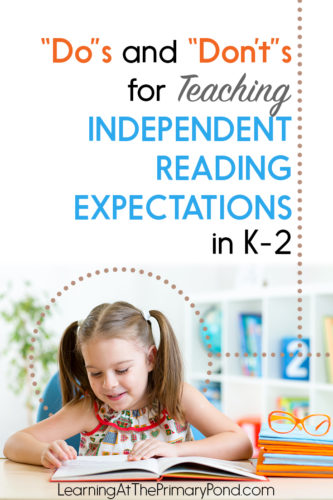
Do…
Treat independent reading as a treat, a treasure, and something to value.
Sure, we have to teach routines and expectations, and help our students build stamina. However, we also have to help our kids WANT to build their reading stamina in the first place!
Before I ever begin teaching routines and expectations for independent reading, I spend time talking with my students about WHY I love reading, asking them what they love to read, and generating excitement for all of the wonderful books we’re going to read during the school year.
Along these lines, you might…
- Bring your favorite book to show the class and explain why you love it
- Give your students a “sneak peek” at some of the books you’ll be reading this year
- Have students draw themselves in their favorite reading place at home (or school, during a previous year)
- Bring in a photo of yourself reading at home and invite students to do the same (make a collage wall)—students who cannot bring a photo can still participate by drawing a picture
- Throw some sort of simple party to kick off independent reading for the year
This part of reading workshop is essential!! Not all of our students will enter our classrooms loving reading or believing that they are readers. However, from the start, we have to help them move in this direction.
Model desired behaviors, and involve students in your demonstrations.
I teach independent reading behaviors just as I teach my students how to write a personal narrative, or how to solve a math problem. I show them what I expect and have them practice it.
The typical structure of my read-to-self minilessons goes like this:
- “Today I’m going to show you _______. Watch while I ______.”
- I demonstrate the desired behavior. (Example: sitting criss-cross with eyes on the book.)
- I call on a student or students to model the desired behavior.
- I ask the other students to comment on what they were doing.
- I invite a student to demonstrate what NOT to do.
- I invite one last student to model proper expectations again. (Ending on a positive note.)
After this minilesson, students have an opportunity to read.
I also love to foster independence with my students! These Interactive Phonics Booklets allow students to have a reference after I’ve taught each phonics pattern. They can grow throughout the year. Students always refer to the booklets when reading independently!
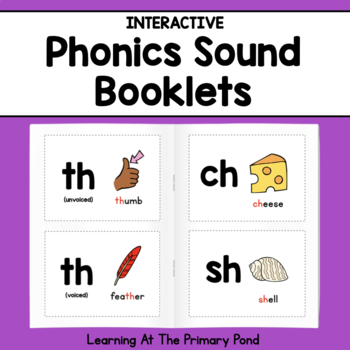
Break things down into bite-sized minilessons.
When I model independent reading (as I describe above), I don’t model everything all at once. I usually have different minilessons to teach:
- How to treat books carefully
- How to begin reading immediately during independent reading time
- How to invent a story from the pictures (for preschoolers / early Kindergarteners who cannot yet decode)
- How to learn from the photos of nonfiction
- How to retell a story you know
- How to show respect to your reading neighbors
- What to do if a reading neighbor is bothering you
- How to store your books in a bag or box
- How to use the classroom library
- How to choose good-fit books that you enjoy reading
- How to reread books for enjoyment
For the first several weeks of school, I teach a minilesson almost every day that focuses on one of these aspects, and then students practice reading independently.
Promote alternative ways of reading.
It’s so important that our students view themselves as readers, even if they aren’t yet reading traditionally! As I listed in the previous section, I devote time to teaching students different ways of reading a book, including…
- Reading the pictures and making up a story (I do this with a picture book written in Japanese or Chinese or another language I can’t read, to make it authentic!)
- Retelling a story I already know (I read TONS of repetitive books and familiar fairy tales at the beginning of Kinder and 1st grade so that students can pretend-read these same books to themselves)
- Learn from the pictures or photos (There is so much that kids can learn from looking at the images in informational text!)
Use tons of positive reinforcement.
I often lose my voice at the beginning of the school year—but it’s for a good reason! I’m constantly pointing out students’ excellent behavior, and this includes during independent reading time.
Of course, I don’t want to interrupt their actual reading time. But as students are getting settled, I say things like:
“I see Nicole already opened her book and is reading—wow!” or “Julio has a stack of five books and is ready to get started.”
After we have independent reading time, I name specific students and the positive reading behaviors that they demonstrated during independent reading time.
I also love to take photos of students who are following my expectations and show them to students after independent reading time is over!
Provide choices, but not all at once.
I like to have my students select their own books, the physical location in the classroom where they read, the way that they respond to texts, and sometimes their sharing partners.
However…I don’t feel obligated to give them ALL of these choices at the beginning of the school year! I prefer to start with structured choices and ease into things.
For example:
- Eventually, my students select books from the classroom library. At the beginning of the school year, I provide them with baskets of books on their tables to choose from. They still have choice, but I give myself time to thoroughly teach them how to use the classroom library.
- Eventually, my students choose their independent reading spots. But at first, they read at their tables. Eventually, I might assign spots throughout the classroom. We gradually work up to free (mostly) choice.
Gradually build stamina.
I’m sure you already know this, but it’s so important to start out small at the beginning of the school year! I usually give my Kinders only 1-2 minutes of independent reading time at the beginning. First graders and second graders might get 5 minutes. We add on a minute every day or every few days until we reach our ultimate independent reading time goal.
Track and celebrate progress.
You might create a bar graph to chart how many minutes students read independently on a daily basis. This is a great way for students to visually see their progress!
Motivate students with sharing time.
At the end of independent reading, I leave a few minutes for sharing time. During sharing time, students can share a favorite picture or part of a book with a partner, or they can share something that they wrote on a sticky note. Start simple at the beginning of the year.
It can be hard to make time for sharing time, but I think it’s so helpful in motivating students to stay on-track during independent reading. It also enables you to make comments like, “I hope you are finding something interesting to share with your partner!” when you notice a student who is off-task. 😉
Don’t…
Stop the entire class just because one or two students are struggling.
I’ve heard it suggested that you should stop independent reading time if even one student gets off-track. The class comes back together, revisits expectations, and then tries again. The purpose of this practice is to set high expectations from the start of the school year and help build stamina. I get that.
HOWEVER. Sometimes I have a little friend (or two) who has a lot of trouble with independent reading. Perhaps there are behavior or attention or emotional issues at play. In these cases, I do not recommend completely stopping independent reading time just because this one child is off-task. The other students may become annoyed, resentful, and not build their own stamina as a result (I’ve seen this begin to happen when I tried this “stopping” practice).
You, of course, have to make your own decisions based upon what you feel is right for your kids! But I highly recommend coming up with other options for kiddos who have unique needs (instead of stopping the entire class). Maybe they can read for a couple of minutes and then draw a picture about what they read. Or maybe you provide them with more support/attention.
Blame yourself if students still haven’t met your stamina goal after a month or two of school.
You might be doing everything “correctly” and still have students who are off-task. Or maybe your class hasn’t reached your stamina goal.
It’s okay! Don’t beat yourself up! These are children, remember? Just like us, they aren’t perfect! 🙂
Although a lot of “stamina building” can take place at the beginning of the year, you still have an entire school year ahead of you. As your students grow and change, you may be able to extend the amount of time that they read independently.
From a perfectionist who wants to get everything done ASAP, I’m telling you…grant yourself some grace if your students aren’t quite where you’d like them to be even after 6 weeks of practice.
Conclusions
If you’re looking for complete lessons to help you teach independent reading procedures or set up reading workshop, check out my new shared reading units HERE!
Also, keep your eyes peeled for some free online workshops that I’ll be teaching—coming in September! You can sign up below to be notified when they are ready:
Happy teaching!!

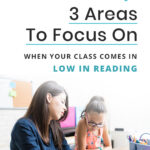
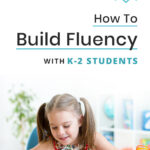


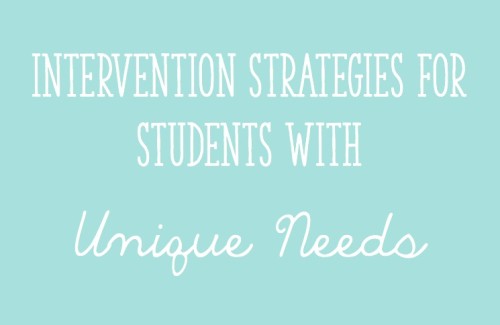
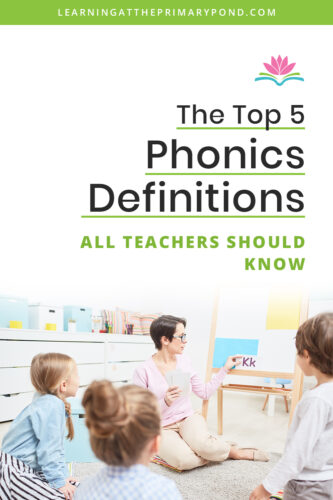






Hi Alison! Thank you for this post! I appreciate the way you blend ideas from the two reading resources you mentioned to make it your own – and realistic to student and classroom needs! I’ve been following you this August as I’ve been prepping for back to school. I’ve purchased some of your amazing resources on TpT and can’t wait to delve into them! Looking forward to jumping in on a workshop soon too!
Erin Salverda
Gr. 1/2 Teacher
Hamilton, Ontario
Canada
Hi Erin! Thank you so much for your sweet comment! I’m so glad the resources have been helpful – feel free to reach out if there’s ever anything I can help with!!
Alison
Excellent article! I am eager to begin using the steps and strategies to build independent reading in my Kindergarten class!
Thanks for providing a plan for rolling out independent reading. You have included many practical ideas!
This was so helpful, thank you
Thank you for sharing your strategies! I started teaching independent reading using the Sisters’ strategies, but never felt the “stop everyone for one” technique really worked. Thanks for the affirmation!
Hey Melissa! So glad this was helpful – thanks for reading!!
Alison
I truly appreciate your reminder to give yourself grace when things aren’t going just perfect. I have also read/heard/been instructed to stop the class if one student is off-task during independent reading, and it was not an effective practice when it came to meeting our goal: actually independent reading. It was a high frustration point in the day for all of us.
Yes!! We aren’t perfect, and neither are our students. Thanks for reading!!
Alison